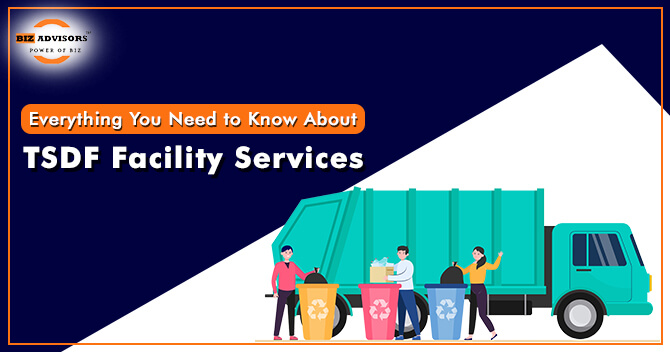Facilities for treatment, storage, and disposal are referred to as TSDFs. To alter the nature and composition of hazardous wastes, treatment facilities classify and apply oxidation or incineration. The TSDF streamlines the environmentally responsible collection, handling, storage, treatment, and disposal of hazardous waste. Hazardous waste can be stored so that it can be kept until it is processed or permanently disposed of at a disposal site. Landfills are the most fundamental kind of disposal facility. In specifically constructed containers that safeguard groundwater and surface water resources, hazardous trash is disposed of. The TSDF welcomes generators and carriers to participate in waste management operations. In comparison to generators or carriers, TSDFs are subject to stricter rules. In this article, we will discuss TSDF Facility Services.
What is TSDF Facility?
Hazardous Waste Treatment, Storage, and Disposal Facilities (TSDFs) facilitate the environmentally friendly collection, transport, receipt, storage, treatment, and disposal of hazardous wastes.
T stands for Treatment facilities, which use a variety of techniques (such oxidation or incineration) to alter the composition of hazardous wastes. While some treatment procedures significantly lower the amount of hazardous waste, certain treatment operations allow the hazardous waste to be recovered and reused in other processes.
S stands for storage facilities, which are places where hazardous materials are temporarily kept until they are processed or disposed of.
D stands for disposal facilities, which are locations where hazardous materials are kept indefinitely. The most typical kind of disposal facility is a landfill or junkyard, where hazardous wastes are dumped in specially built-containers made to safeguard groundwater and surface-water resources.
The generator and transporter are joined in the waste management process by the treatment, storage, and disposal facility (TSDF). In comparison to rules that apply to generators or transporters, TSDF requirements are tighter.
Obligations of TSDF Facility Services Provider
1. The CPCB recommendations on “Implementing Liabilities for Environmental Damages due to Handling and Disposal of Hazardous Waste and Penalty” must be followed by the TSDF Facility Service provider.
2. When implementing the Emergency Response Procedure (ERP) for which the authorization is issued, the authorization holder must take into account all site-specific potential circumstances (spillages, leakages, fire, etc.).
3. The transported, accidental occurrence, and the implemented waste disposal system must adhere to the requirements of the certificate of authorization.
4. For the period ending on March 31, the occupier must submit the annual return by June 30 using Form 4.
5. Hazardous and other wastes should not be kept on-site for more than 90 days by the occupier. In accordance with the HOWM Rules, France, 2016, this requirement may change under specific circumstances. and clean-up procedures of the imported hazardous and other wastes must be completely covered.
6. Maintain collection, storage, and disposal records in accordance with Form 3.
What conditions must be met in order to store hazardous waste using TSDF Facility Services?
1. In a storage facility, there should be separate columns for wastes that are combustible, ignitable, reactive, and incompatible.
2. The distance between the storage sheds must be at least 15 meters.
3. The container must be constructed or lined with a material that is appropriate and won’t react with the hazardous wastes it is holding.
4. Any spills or leaks should be cleaned up with cotton, not water.
Documents required for TDSF Facility Services
If TSDF Facility Service satisfies all requirements and submits the required paperwork, the SPCB will grant authorization.
1. Completed Form I
2. The facility’s registration for GST
3. A copy of the emergency response plan (ERP) outlining the steps to take in case of an emergency (like spillage, accidental release, or fire)
4. A copy of the SPCB’s most recent consent order
5. Evidence of installed pollution prevention tools
6. The TSDF’s layout plan has been approved.
7. A copy of the compliance report and the previous environmental clearance.
A TSDF Facility Service’s components
Treatment facilities:
These establishments use scientific procedures (such as incinerating or oxidizing) to change the nature or makeup of hazardous wastes.
Hazardous wastes are intended to be temporarily held in storage facilities until they are handled or disposed of.
Disposal services
These are locations where hazardous wastes are removed or disposed of in units that have been properly built to preserve groundwater and surface-water resources.
Process for TSDF Facility Services Authorization
Any TSDF facility that wishes to engage in the collection, storage, transport, receipt, recycling, reuse, recovery, pre-processing, co-processing, use, treatment, or disposal of hazardous and other waste must obtain prior authorization from the relevant SPCB. The applicant must submit a Form 1 application to the relevant SPCB in order for the authorization to be granted or renewed. If the TSDF facility is owned by the hazardous waste generator, it will also require equivalent authorization. The applicant must include information on the type of waste handled or stored, its annual volume, details regarding treatment facilities, machinery installed and its capacity, a leachate collection system, firefighting procedures, transportation information, the location of the site, and any other details that SPCB may require.
Additional Requirements for Hazardous Waste Recyclers and Processors
Other treatment procedures can significantly lower the amount of hazardous waste, while certain treatment facilities allow trash to be collected and reused in manufacturing environments. Therefore, if a TSDF recycles, pre-processes, co-processes, or uses hazardous waste in addition to treating, storing, and disposing of it, it must completely fill out Part D of Form 1. Such facilities will be required to provide additional information, such as the amount of waste received (domestic or through import), their capacity, a description of the recycling process, a flowchart of the process, information about the users of the by-products, a description of their pollution control system, and CPCB[1] compliance reports.
Validity and Renewal of TSDF Service Authorization
Validity:
Subject to the conditions stated in the Certificate, the TSDF authorization certificate is valid for five years.
Renewal:
If the authorization is to be renewed, a TSDF must provide a copy of the last three years’ worth of annual returns. Along with the required documentation listed in the previous section, effluent, emission standards, and conditions indicated in the authorization for hazardous and other wastes self-certified compliance reports will also be required for the renewal of the authorization.
Conclusion
Toxic substances included in the hazardous waste can be harmful to both individuals and the environment. As a result, hazardous waste needs to be dealt with and disposed of before being released into the environment. Chemical, biological, and physical techniques can all be used to remediate hazardous waste. Hazardous Waste has harmful properties that can affect both living things and the environment. It is crucial to treat hazardous trash before releasing it into the environment because of this. Methods for treating hazardous waste include chemical, biological, and physical processes. Seek professional advice to get TDSF Facility Services. You can also reach Bizadvisors.io for more information.
Read our article:All You Need to Know About Authorization for Export of E-waste
 9559179325
9559179325 9559179325
9559179325





